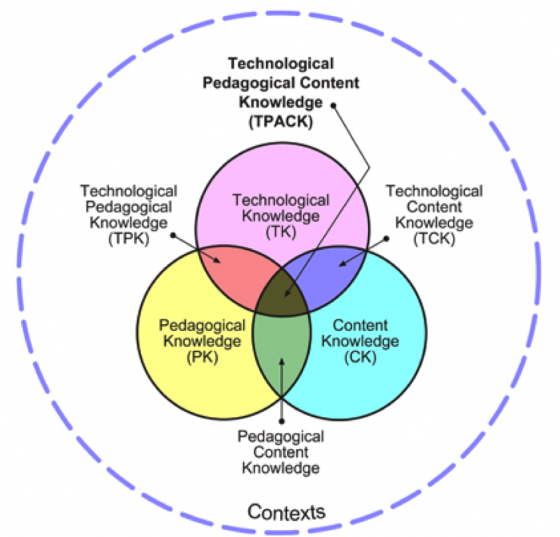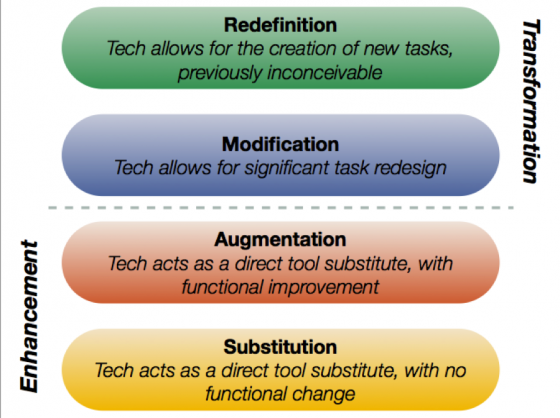Voices blogger Jenny Luca teaches at an independent school near Melbourne, Australia.
How do you make change happen beyond your classroom? When I started writing about how technology was changing my approach to teaching and learning, my focus was initially on my immediate classroom and the changes happening there. But I’m a Teacher-Librarian. I work not only in an English classroom where I hold court, but across all year/grade levels working with teachers and students in many different subject areas.
It became obvious to me that systemic change was necessary to enable all our students to benefit from the opportunities created by technology and connectedness. Over the past year, the team I work with has been leading change in our school, working to expand our understandings about 21st century information fluency and help our students grow as digital citizens.
This means addressing all of the traditional information literacy we’ve always concentrated on, but also helping our students understand new technologies and how to use them effectively, become ethical users of digital resources, and learn the importance of creating and maintaining a positive digital footprint. And it’s not only the students who need this knowledge base: Our teachers need to be well versed too.
So what are we doing about this?
At the end of 2010, with the support of our Head of Learning, we presented what we called an Information Fluency Initiative to our Heads of Faculties and proposed we begin the introduction of this for 2011. First up, we introduced to our staff the idea of Technological Pedagogical Content Knowledge – the TPACK model, developed by Koehler & Mishra.
Source: http://tpack.org/
When using this graphic with staff, I see a lot of nodding heads. They understand the need to integrate technology to support their content knowledge and pedagogical practice. But they don’t always know how to do this using new technology tools that support meaningful learning and aren’t just gimmicky add-ons. As Teacher-Librarians, my team works hard at staying on top of new ideas in this arena. We have committed to work closely with our staff, both in the library and in classrooms, to help staff and students come to grips with new ideas using technology to support their learning.
As they look at existing and new ideas for curriculum offerings, we’re encouraging our staff to use the SAMR model to inform their planning. I first saw this graphic showing stages of technology integration last year at our Association of Independent Schools Conference, where Martin Levins was leading a sandpit group talking about how to use it to modify learning tasks.
Again, when explaining this model I see heads nodding in agreement. Teachers ‘get it’ when you use models like this, and they pay attention to models that have a research base. SAMR was developed by Ruben Puentedura, and from my perspective, along with TPACK, it should be the basis of any discussion in schools about the use of technology in the development of learning tasks.
The next layer of our Information Fluency initiative was the development of Information Fluency certificates for Year 7, 8 and 9 students. The certificates are an invention of ours — a means to measure acquisition and as a way to give the kids a sense that they have achieved something. These have been created using the ISTE NETS for Students standards as the basis. They identify as critical for today’s students the ability to:
â– Demonstrate creativity and innovation
â– Communicate and collaborate
â– Conduct research and use information
â– Think critically, solve problems, and make decisions
â– Use technology effectively and productively
We have used ISTE’s NETS.S curriculum planning tool to help us identify skills we think students should have acquired by the end of each year. We were looking to develop an identifiable skill set that we could measure in terms of acquisition. I’m not a strict proponent of a ‘tick the box’ measuring scale — not by any stretch of the imagination. But I did want something concrete that we could use with our students and staff.
We also recognised the need to address our evolving Australian Curriculum and looked to ACARA (our nation’s independent authority responsible for the development of a national curriculum) to see what was being developed there. What is contained within the General Capabilities underpins meaningful teaching and learning, and is really quite closely aligned with the ISTE NETS for Students. What we have done is to tag each skill within our Information Fluency Certificates with the appropriate General Capability it addresses. As our teachers plan curriculum, we feel these certificates will help them to identify how they can embed new technologies and practice into their delivery of curriculum, knowing that they are addressing aspects of the General Capabilities that ACARA has identified as necessary.
Developing Student ePortfolios
What has taken up considerable time this past year has been the introduction of an Edublogs platform to enable all students from Years (grades) 7 – 10 to have an ePortfolio as a means of documenting and demonstrating their learning.
In the early stages of planning this Information Fluency initiative, I could see we were going to need some means of sharing the learning that was happening in classrooms. We investigated a WordPress multi-user setup, but felt that the management of this would fall on individuals already tied up with full loads — and our under the pump IT team, who already work tirelessly to maintain a robust network.
We decided that a fee-based Edublogs platform — one that allows for blogs to be set up with our school’s domain name and comes with support — would be a more workable option. The initial creation and linking of blogs to homepage class blogs took some time at the start of the year, as did the effort to teach students how to manage their blogs/ePortfolios. We have allowed students to select their own themes and customise sidebars with widgets.
 One of the critical elements of the set up was having students create categories within their blogs/ePortfolios. We recommended they create a category for every subject they were studying, and other categories that reflected key school directions and co-curricular involvement. Students were taught how to write their posts and tag a category or multiple categories to each post. This has made it easy for subject teachers to check into student blogs, click on their subject category, and see all of the posts written by that student for their subject area.
One of the critical elements of the set up was having students create categories within their blogs/ePortfolios. We recommended they create a category for every subject they were studying, and other categories that reflected key school directions and co-curricular involvement. Students were taught how to write their posts and tag a category or multiple categories to each post. This has made it easy for subject teachers to check into student blogs, click on their subject category, and see all of the posts written by that student for their subject area.
We have encouraged our teachers to use these these blogs/eportfolios for formative assessment, and students have been encouraged to use them on their own initiative to write about what they have been doing in their classrooms and in co-curricular activities. Over the course of the year we have seen some wonderful ePortfolios created, supported by teachers who can see the positive benefits for our students as they create their own digital footprint.
When you see a student’s eportfolio/blog as Google’s top result for a search for Yr 7 Unit of Inquiry, it’s pretty impressive. (One of our staff members was conducting just such a search, and sent me an email excitedly relaying what she’d found!) Students have embedded Clustrmaps in their sidebars, and have seen the reach they have by writing in public spaces. We’ve even recently had the author Susanne Gervay leave a comment on a student’s post discussing her novel, ‘Butterflies’. Not every student ePortfolio is brilliant, and some year levels are working much better than others, but we are in our infancy still. It’s accepted that this is part and parcel of the pedagogy now, and we will continue to develop the platform in 2012 and onwards.
What these blogs already do is provide terrific feedback for students, something that has been a key focus area for our staff as we explore elements of John Hattie’s research. It’s also really encouraging to see students providing feedback to other students — they are remarkably supportive of one another. We’ve also seen parents and grandparents leave comments. It’s this critical school/home nexus that can help our school move closer to a Networked School Community, of the type proposed by Associate Professor Glenn Finger and Mal Lee.
What’s next
Our Edublogs platform reveals that our students are developing skills identified on the Information Fluency Certificates we created. Last year we just used them in our team to gauge how we were progressing and did not formally use them with the kids. This year we intend to implement them fully. We do recognise the need for the certificates to be fluid documents responding to new technologies as they arise. It’s important that they present our students with new opportunities and challenges.
2011 has been a year of development, and 2012 will be a year of full implementation (our school year in Australia is just about to begin again). We need to map our curriculum to ensure all areas of our faculty gain the skill set and understandings we have identified as being critical for the development of effective citizens in our world today. This is not easy work, particularly as it often means teachers need to accept the idea of working in a co-teaching capacity if they themselves don’t have the necessary skill set.
Something I would like to look closely at next year is the AITSL (Australian Institute for Teaching and School Leadership) National Professional Standards for Teachers and see how the work we are doing aligns with these standards. Helping teachers see the connectedness between school initiatives and their professional development is an important part of this process. I heard recently from someone working in this area and look forward to exploring that work more.
As a Teacher-Librarian, I know this is critical work. We can be change agents in our school, and in the process, do the best kind of advocacy we can for our profession. I believe this is the job of a Teacher-Librarian today. If you are prepared to stay abreast of change and develop the skill set that can move your school and student population where they need to be, you have a future.
What about schools in other places? What steps are you taking to shift your school, build a networked community, and change your teaching and learning in transformational ways?
Jenny Luca
Latest posts by Jenny Luca (see all)
- Venturing into Project-Based Learning - October 19, 2012
- How to Prepare for a TEDx Talk - September 7, 2012
- TED in My Classroom - March 16, 2012



